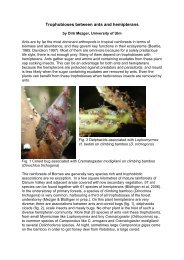Identification guide to the ant genera of Borneo - AntBase.net
Identification guide to the ant genera of Borneo - AntBase.net
Identification guide to the ant genera of Borneo - AntBase.net
Create successful ePaper yourself
Turn your PDF publications into a flip-book with our unique Google optimized e-Paper software.
Y. HASHIMOTO<br />
Glossary <strong>of</strong> Ant Morphology<br />
Abdomen<br />
The abdomen in worker <strong>ant</strong>s consists <strong>of</strong> seven<br />
visible segments (A1-7). The first abdominal<br />
segment is <strong>the</strong> propodeum (PPD, A1), which<br />
immovably fused <strong>to</strong> <strong>the</strong> thorax. The second<br />
abdominal segment is <strong>the</strong> petiole (PT, A2).<br />
Abdominal segment 3 is <strong>the</strong> first gastral segment<br />
when it is full-sized and broadly articulated <strong>to</strong> <strong>the</strong><br />
following segment (A3), but when reduced and<br />
isolated it is called <strong>the</strong> postpetiole (PPT).<br />
Abdominal segment 3 or 4 through <strong>to</strong> 7 is called<br />
<strong>the</strong> gaster (GA). The last visible abdominal tergite<br />
(A7) is <strong>the</strong> pygidium (PY), and <strong>the</strong> last visible<br />
sternite is <strong>the</strong> hypopygium (HY).<br />
See Petiole.<br />
Acidopore (AC)<br />
It is <strong>the</strong> orifice <strong>of</strong> <strong>the</strong> formic acid projecting system,<br />
which is formed from apex <strong>of</strong> <strong>the</strong> hypopygium,<br />
appearing a short nozzle, <strong>genera</strong>lly with a fringe <strong>of</strong><br />
short setae.<br />
Alitrunk (Mesosoma)<br />
The alitrunk consists <strong>of</strong> <strong>the</strong> three segments <strong>of</strong> <strong>the</strong><br />
true thorax (pro-, meso-, and metathorax) <strong>to</strong> which<br />
is fused <strong>the</strong> propodeum (<strong>the</strong> tergite <strong>of</strong> <strong>the</strong> first<br />
abdominal segment), <strong>to</strong> form a single unit (AL).<br />
Pronotum (PN): The dorsal sclerite <strong>of</strong> <strong>the</strong> prothorax.<br />
In <strong>ant</strong>s, <strong>the</strong> pronotum extends across <strong>to</strong> dorsum and<br />
down <strong>the</strong> sides <strong>of</strong> <strong>the</strong> prothorax.<br />
Propleuron (PR): The lateral part <strong>of</strong> <strong>the</strong> prothorax.<br />
In <strong>ant</strong>s, <strong>the</strong> propleuron is concealed by <strong>the</strong> lateral<br />
part <strong>of</strong> <strong>the</strong> propleuron.<br />
Mesonotum (MS): The dorsal part <strong>of</strong> <strong>the</strong> mescthorax.<br />
In <strong>ant</strong>s, <strong>the</strong> mesonotum may be separated from <strong>the</strong><br />
pronotum by <strong>the</strong> promesonotal suture (PMS), or<br />
may be fused <strong>to</strong> it <strong>to</strong> form a single sclerite, <strong>the</strong><br />
promesonotum (prs).<br />
Mesopleuron (MSP): The lateral and ventral part <strong>of</strong><br />
<strong>the</strong> mesothorax. The mesopleuron may consist <strong>of</strong> a<br />
single sclerite or may be divided by a transverse<br />
groove in<strong>to</strong> an upper and a lower part .<br />
138 Part 3 - COLLECTING, HANDLING, IDENTIFICATION AND STORAGE FOR SELECTED GROUPS




